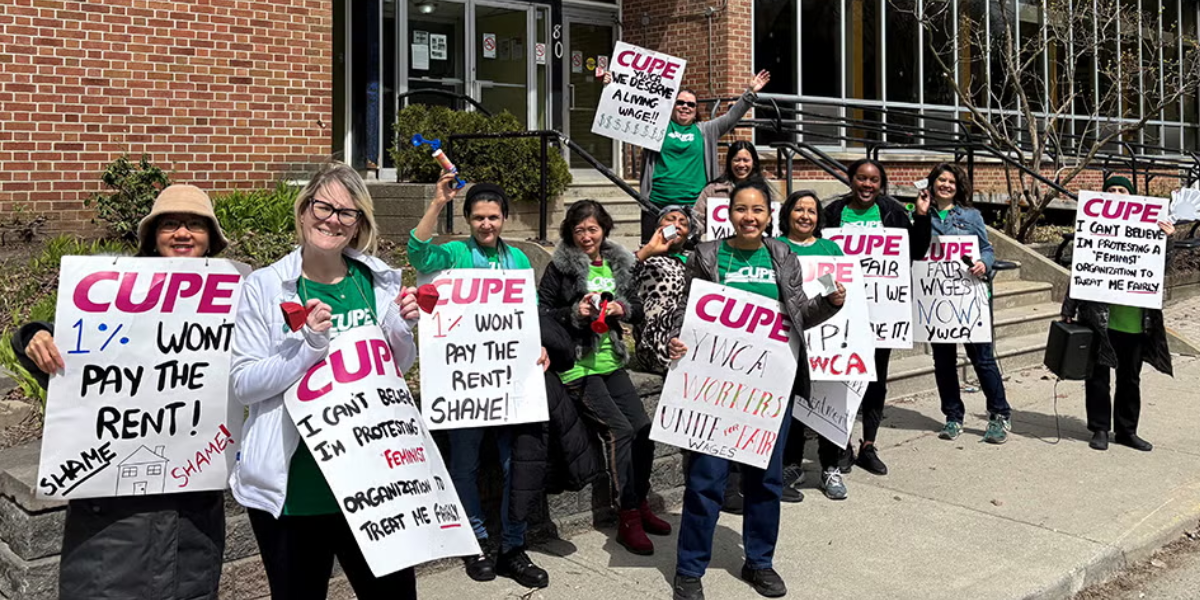250 workers unionized with CUPE 2189 ratified their newest collective agreement in May after five months of negotiations, averting a looming strike-lockout situation. By using strong organizational and mobilizing methods, the union won an average 11 percent increase for their workers’ wages, alleviating many of them from housing insecurity and reliance on food banks, among other gains.
Negotiations begin
In December, the YWCA sat down to negotiate with their employees, who include shelter workers, childcare and employment service providers, and counselors for survivors of violence against women.
At the beginning of the negotiations period, the workers at YWCA had been working on an expired contract for over a year. Under this agreement, there were full-time workers being paid less than $38,000 per year. While not every worker at the YWCA was being paid this amount, most of the workers at the YWCA were being paid so little that they could qualify for the same services they were providing members of the community. Over 70 percent of their workers were struggling to pay the bills, 46 percent had cut back on food purchases, and 10 percent were regularly using the food bank. Some workers were even working three jobs to survive.
The YWCA tabled its first deal offer in December. The union and its membership’s response was widespread dissatisfaction. They expressed disappointment at the lack of an equitable wage increase, and the union asked for a conciliation officer soon after the employer expressed that they had already hit the limit on how high they were willing to raise wages. Amanda Kinna, president of the CUPE 2189 executive board, said, “They did not seem to be coming to the table with what we thought was a fair offer, but they were presenting it as something that we should accept, which gave way to some tension.”
Mary Gomes, a representative of the Strike Averting committee, said the first deal was disrespectful to the amount of work union membership does for the employer. The union, unwilling to accept a deal they saw as unfit, filed a no-board. “A lot of folks were really upset and dissatisfied with what was happening. Everyone was outraged. That’s when the ball started rolling,” said Gomes. By the end of January, the membership had voted 99 percent in favor of a strike.
Mobilization begins
After the strike vote, CUPE 2189 was in a historic position. The workers at the YWCA have never gone on strike before. They mobilized a small cadre of union activists and set up a Strike Averting Committee. CUPE National collaborated with the local and trained its members in strike planning, training, and averting. Union activists spent a lot of time having conversations with their coworkers educating them on what the strike would look like, what the strike committee was doing, what was being done to avert the strike, and why.
The union also began using “informational pickets,” in which they showed up to half of the 15 YWCA social service sites during lunchtime and staff breaks, stood on public property, and held conversations with workers and community members. They would alternate sites depending on the day, picketing during their own unpaid time and without barring anyone from entering, as they had not initiated a strike. Since they were not on strike, they had to stand on public property and keep moving around the site in an effort to avoid accusations of loitering.
At one location, the workers rented out an ice cream truck and a speaker, handing out dessert while educating union membership and the community on what their conditions were like and how the employer was behaving.
Kinna said, “we started taking action because we knew we had to fight to get more wages and a fair deal. We felt like they weren’t willing to come back to the table until we pressured.”
The community shows up
During some of the informational pickets, community members living in the housing sites turned curious and approached the picketing workers. After receiving the news from the picketers that they might go on strike, some panicked, asking if services would be disrupted. But soon enough, some community members joined the pickets, doing their best to help avoid the strike. Hundreds of people joined the rallies—some with food and drinks—while over one thousand sent emails to the YWCA board of directors urging them to hear out the union.
CUPE 2189 mentioned appreciation for the support they received from the community, including from CUPE Ontario, CUPE National, and MPP Kristyn Wong-Tam of the New Democratic Party.
Winning a wage increase, and averting a strike
After some mobilizing, the employer met with the union twice in early March, but scheduled a meeting later in the month that fell through. The union kept pressuring the employer, however, and ended up securing a new deal in May. The new contract means an average 11% increase to wages over the course of three years, alleviating the pains of CUPE 2189 workers who rely on food banks and are suffering through housing insecurity. The deal also includes some improvements to the union’s ability to organize and a one-time signing bonus.
Regarding the uncertainty felt before the new deal was secured, Gomes stated that, “It was a scary situation because before the tentative agreement and its ratification, the strike averting committee could have switched to a strike committee.” Before the deal, union activists were still preparing for things to fall through. “You could see the uneasiness in our team, but we stuck together and were determined to fight for what was right. To fight for our wages,” said Gomes.
The union is proud of how its membership reacted to the situation. Kinna had this to say about the process: “Our members are definitely mobilized now. We’re neither a huge nor a small local, but with some guidance from CUPE we were able to take control of our power and we were able to push through. In the end, it was worth it.”
Did you like this article? Help us produce more like it by donating $1, $2, or $5. Donate


